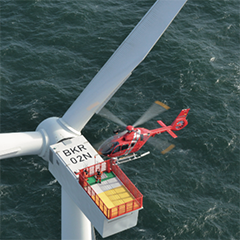Hardly any industry is growing as fast as the offshore-wind energy sector. The helicopter operator HTM Helicopter Travel Munich GmbH, has supported offshore alternative energy from the very beginning. Today, the company is one of the leading providers for helicopter hoist-missions to offshore wind turbines and their substation platforms. PES is delighted to bring you this exclusive.
It’s early in the morning on the airfield of the East Frisian City of Emden (EDWE) and even at this time there is a hustle and bustle. Ground handlers are towing helicopters over the apron, refueling them and the first passengers are arriving at the check-in area. A strong and cold wind is blowing, a perfect day for flying, at least for the HTM crews.
As soon as the wind turbines are out of service and the waves too high to transport the trouble shooting teams, via CTV (a special Crew Transfer Vessel), the hour of action sounds for the Emden based helicopter operator. Time is money and an unserviceable wind energy plant produces costs instead of earning profit (12.000-30.000 euros a day on windy days). Therefore, the top goal of HTM is to serve their customers timely, safely with utmost flexibility flexible.
One day offshore
Normally the technicians fly to the windfarm in the morning, do their job at the wind turbine or converter platform (OSS), and return in the afternoon or evening. This is a typical mission makes up 60 to 80% of HTM’’s work load, in the offshore business.
Once at the airfield, the passengers receive a safety briefing, comparable with those on airline flights. The crew for hoist flights is normally a pilot and a hoist operator. At the moment HTM operates single pilot VFR, who prepares their flight documentation, checks the weather and creates the flight plans.
After weighing the passengers and their cargo the fuel quantity is calculated for the planned mission. Next the helicopter is pulled out of the hangar and is refueled for the flight. This is done by the hoist operator or the ground handling staff. About 15 minutes prior to the planned takeoff the passengers are asked to put on their survival suit: a survival suit is mandatory, as well as a safety vest with a breathing system.
For hoist missions the passengers also carry a special ETSO (European Technical Standard Order) certified harness and a hoist extension, plus their helmets, which often include a radio, and gloves. The ground ops personnel then drive the passengers and the crew to the helicopter, ready on the apron.
Now the ground handlers hand the passengers over to the flight crew. HTM´s aim is a close relationship between the crew and the occupants. The passengers have the chance to talk to pilot and hoist operator at any time, whilst on their base. Many technicians and flight crews have known each other for a long time, which is of great benefit when working together and for mutual confidence.
Prior to boarding the helicopter flight crew checks the right fitting and the condition of the passengers PPE one last time and gives them a final safety briefing if needed. Now the flight can depart. Shortly before reaching the wind turbine the cabin and its occupants are checked by the hoist operator for the upcoming hoist mission. The pilot reduces the airspeed until reaching the minimum speed for opening the cabin’s sliding door.





















